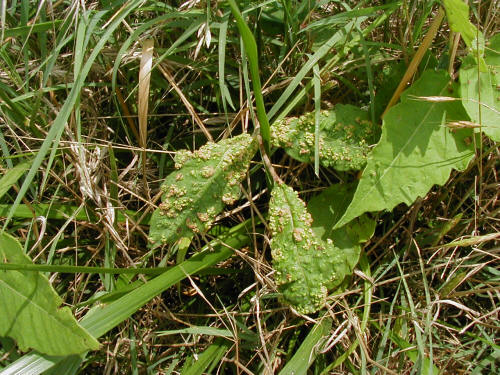Poison Ivy
Toxicodendron radicans (L.) Kuntze
Anacardiaceae (Sumac Family)
▲ seedling
▲young shoots emerging in spring from creeping roots ▲

▲common "warts" seen on some poison ivy ▲leaves
▲▼vine climbing a tree
▲aerial roots from vine that allow it to cling to bark for climbing
▲▼ flowering plants
▲mature fruit
▲▼ plants showing their red-orange fall color
Location near campus: growing on and near small garage along alley south of Grand, just east of Kings St.
Toxicodendron radicans
(L.) Kuntze; Eastern Poison-ivy:
(Bayer Code:
TOXRA; US Code TORA2)
·
Woody
perennial vine or shrub with creeping roots in the Cashew Family (Anacardiaceae)
·
Leaves
have 3 leaflets; shiny green in summer, sometimes with warts; bright
red-orange in fall
·
Leaflets may have smooth margins or a few angular teeth
·
Clusters
of white flowers in spring, followed by white berries by autumn
·
Very
potent contact dermatitis agent causing itchy sores to develop and spread
from point of contact; only takes 20 seconds for protein/allergenic complex
to bind to skin; however, not all people develop allergic reactions from
contact
·
All
parts of plant contain a contact poison (urushiol)
that causes itching, and development of fluid-filled pustules on the skin
(eyes, mouth, lungs, etc.) of sensitive people/animals; plant is poisonous
when dormant as well as when
actively growing; even smoke from burning stems and leaves can cause
allergic reaction inside lungs
·
In Missouri, this is the main species present; poison oak species are not
known, or at least not common
·
Another poison ivy sometimes listed as a separate
species:
o
Toxicodendron rydbergii
(Small ex Rydb.) Greene; Western Poison-ivy:
(Bayer Code:
not known; US Code TORY)
o
Some list
western
poison-ivy (Toxicodendron
rydbergii)
as a separate species from
eastern poison-ivy (Toxicodendron radicans),
that only forms colonies of 2-4 foot tall, single-stemmed or few-branched
plants arising from spreading rhizomes—it does not climb as a vine—but stem,
leaf and fruit characteristics are similar to
Toxicodendron
radicans, so some botanists believe they are
the same species